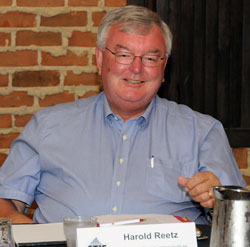 In an era of continued concern for the environment and tighter regulations, it simply makes sense to ensure we practice precision crop protection application on every acre.
In an era of continued concern for the environment and tighter regulations, it simply makes sense to ensure we practice precision crop protection application on every acre.
To this end, the Center for Integrated Pest Management (CIPM) announced the launch of a new Pesticide Environmental Stewardship (PES) website. The site (http://pesticidestewardship.org) is designed for anyone who applies, sells, stores, or disposes of pesticides; provides advice or training on pesticide use; or is involved in pesticide stewardship or regulation.
“Our ultimate goal is to cover the basic tenets that apply regardless of who you are, where you live or the pest you’re trying to control,” says Wayne Buhler of North Carolina State University, PES national coordinator and a Pesticide Safety Education Program coordinator for North Carolina. “There are fundamental principles and practices to be aware of whether you are protecting agricultural crops, homegrown vegetables, a lawn or golf course. We hope that whenever the choice is made to use a pesticide, good stewardship practices will be followed.”
The new website complements the work of county extension agents and state-level Pesticide Safety Education programs. It covers a wide variety of stewardship topics, ranging from pesticide storage, handling and disposal…to how to avoid drift, runoff and leaching during and after the application. Homeowners can go straight to a section geared to their needs.
Buhler’s colleagues in the Pesticide Safety Education Program from across the United States were instrumental in the development of PES, including Ron Gardner of Cornell University, Carol Ramsay of Washington State University, Jim Wilson of South Dakota State University and Fred Whitford of Purdue University. Other scientists in academia, extension, government and industry (http://pesticidestewardship.org/Pages/About.aspx) partnered with CIPM on the project, including members of the Weed Science Society of America, the Entomological Society of America and the American Phytopathological Society.
“We know there is a wealth of expertise in the public and private sector regarding pesticide stewardship,” observes Ron Gardner. “We look forward to a growing list of partners who will help us add value to current and future topics on the site.”
A pesticide resistance management topic is currently under development. Future plans include educational quizzes to reinforce important stewardship concepts and self-assessment tools to evaluate personal stewardship practices.
“Search the web for phrases like ‘pesticide stewardship and drift’ and you will get thousands of results,” says Carol Somody, senior stewardship manager for Syngenta Crop Protection and PES industry coordinator. “It can be quite overwhelming to someone who wants to start with the basics, and teaching the basics is the purpose of PES. It provides a much-needed entry point to essential pesticide stewardship information.”
10 Stewardship Tips from the Pesticide Environmental Stewardship (PES) Website
1. Read the label before buying the pesticide.
2. Buy only the amount of pesticide needed for one season.
3. As a general rule of thumb, the temperature inside the storage area should not get below 40 F or over 100 F.
4. Calibrate equipment carefully to assure that the pesticide is applied at labeled rates.
5. Be aware of the current and probable future weather conditions in order to make the best application decisions to prevent drift.
6. Locate the mixing/loading site away from wells, streams and lakes.
7. Never leave a tank while it is being filled and pay constant attention during filling to prevent overfilling and spilling of the pesticide on the ground.
8. When you empty a container, allow it to drain into the spray tank for 10 seconds after it begins to drip.
9. Remember that exceeding the label rate of application is a violation of the law!
10. Follow the label each time you mix and use the pesticide, and follow the label when storing or disposing of the pesticide. Do not trust your memory.
 Make the trek to central Iowa near Boone for the nation’s greatest summer agricultural showcase, the annual Farm Progress Show, held August 31 through September 2.
Make the trek to central Iowa near Boone for the nation’s greatest summer agricultural showcase, the annual Farm Progress Show, held August 31 through September 2.






 As the dog days of summer heat up and are still delivering too much rain in many areas of the central Corn Belt, it’s a good time to pull out the combine manual and start gearing up for Midwest corn and soybean harvest.
As the dog days of summer heat up and are still delivering too much rain in many areas of the central Corn Belt, it’s a good time to pull out the combine manual and start gearing up for Midwest corn and soybean harvest.

 Harold Reetz, who founded the
Harold Reetz, who founded the 

